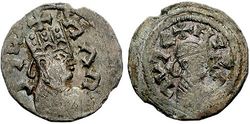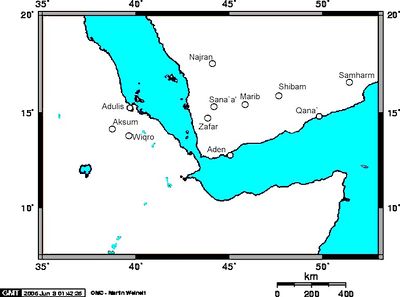كالب من أكسوم
| كالب ካሌብ ካሌብ እለ አጽብሐ: ʾƎllä ʾAṣbəḥa إلاّ أصبحا Ελεσβόάς እለ አጽብሐ: إلسبواس) مملكة أكسوم | |||
|---|---|---|---|

|
| القديس إلـِسبان Saint Elesbaan | |
|---|---|
| ملك إثيوپيا | |
| وُلِد | ح. 510 |
| توفي | ح. 540 |
مكرّم في | الكنائس الأرثوذكسية المشرقية الكنائس الأرثوذكسية الشرقية كنيسة الروم الكاثوليك |
| عيده |
|
كالب (ح. 520)، قد يكون الأفضل توثيقاً، إن لم يكن أشهر، ملك إكسوم التي كانت تقع في إرتريا وإثيوپيا المعاصرة.
أطلق عليه پروكوپيوس من قيصرية "هلـِسثيايوس" Hellestheaeus، وهي تنويعة من يونانية كوينى: Ελεσβόάς وهي نسخة من أسماء عرشه إلا أشبحا گعيز: እለ አጽብሐ ʾƎllä ʾAṣbəḥa (التواريخ، 1.20). من تنويعات اسمه الأخرى هـِلـِسثايوس، إلسثايوس، إلشاه، إيلا أتسبـِبها، إيلسبواس، وإلسبوام، وجميعها مشتقة من اليونانية Ελεσβόάς، وتعني"الشخص الذي أوجد الصباح" أو "الشخص الذي يجمع الجزية".
At Aksum, in inscription RIE 191, his name is rendered in unvocalized Gə‘əz as KLB ’L ’ṢBḤ WLD TZN (Kaleb ʾElla ʾAṣbeḥa, son of Tazena). In vocalized Gə‘əz, it is ካሌብ እለ አጽብሐ (Kaleb ʾƎllä ʾAṣbəḥa).
Kaleb, a name derived from the Biblical character Caleb, is his given name; on both his coins and inscriptions he left at Axum, as well as Ethiopian hagiographical sources and king lists, he refers to himself as the son of Tazena.[6]
التاريخ
Procopius, John of Ephesus, and other contemporary historians recount Kaleb's invasion of Yemen around 520, against the Himyarite king, Yusuf Asar Yathar, known as Dhu Nuwas, a Jew who was persecuting the Christian community of Najran. After much fighting, Kaleb's soldiers eventually routed Yusuf's forces and killed the king, allowing Kaleb to appoint Sumuafa' Ashawa', a native Christian (named Esimiphaios by Procopius), as his viceroy of Himyar.
As a result of his protection of the Christians, Kaleb is known as St. Elesbaan after the sixteenth-century Cardinal Caesar Baronius added him to his edition of the Roman Martyrology despite his being a miaphysite.[7][8][9] However, the question of whether Miaphysitism—the actual Christology of Oriental Orthodoxy, including the Coptic Orthodox Church of Alexandria)—was a heresy is a question which remains to this day.
Axumite control of Arabia Felix continued until c.525 when شميفع أشوع was deposed by Abraha, who made himself king. Procopius states that Kaleb made several unsuccessful attempts to recover his overseas territory; however, his successor later negotiated a peace with Abraha, where Abraha acknowledged the Axumite king's authority and paid tribute. Munro-Hay opines that by this expedition Axum overextended itself, and this final intervention across the Red Sea, "was Aksum's swan-song as a great power in the region."[10]
A historical record survives of a meeting between the Byzantine ambassador and historian Nonnosus and Kaleb in the year 530. [11]
Ethiopian tradition states that Kaleb eventually abdicated his throne, gave his crown to the Church of the Holy Sepulchre at Jerusalem, and retired to a monastery.[12]
Later historians who recount the events of King Kaleb's reign include ابن هشام، ابن إسحاق، والطبري. Taddesse Tamrat records a tradition he heard from an aged priest in Lalibela that "Kaleb was a man of Lasta and his palace was at Bugna where it is known that Gebre Mesqel Lalibela had later established his centre. The relevance of this tradition for us is the mere association of the name of Kaleb with the evangelization of this interior province of Aksum."[13]
Besides several inscriptions bearing his name,[14] Axum also contains a pair of ruined structures, one said to be his tomb and its partner said to be the tomb of his son, Gabra Masqal. (Tradition gives him a second son, Israel, whom it has been suggested is identical with king Israel of Axum.[15]) This structure was first examined as an archaeological subject by Henry Salt in the early 19th century; almost a century later, it was partially cleared and mapped out by the Deutsche Aksum-Expedition in 1906. The most recent excavation of this tomb was in 1973 by the British Institute in Eastern Africa.[16]
The Eastern Orthodox Church commemorates Kaleb as "Saint Elesbaan, King of Ethiopia" on 24 October (O.S.) / 6 November (N.S.).
انظر أيضاً
الهوامش
المصادر
- ^ Blessed Elezboi, Emperor of Ethiopia. HOLY TRINITY RUSSIAN ORTHODOX CHURCH (A parish of the Patriarchate of Moscow).
- ^ Blessed Elesbaan the King of Ethiopia. OCA - Feasts and Saints.
- ^ Synaxarium. Ginbot 20 (May 28). Ethiopian Orthodox Tewahedo Debre Meheret St. Michael Church. Retrieved: 2012-10-30.
- ^ Synaxarium: The Book of the Saints of The Ethiopian Orthodox Tewahedo Church. Transl. of Sir E.A. Wallis Budge. Printed by the Ethiopian Orthodox Tewahedo Debre Meheret St. Michael Church, Garland, TX USA. p.764.
- ^ The Roman Martyrology. Transl. by the Archbishop of Baltimore. Last Edition, According to the Copy Printed at Rome in 1914. Revised Edition, with the Imprimatur of His Eminence Cardinal Gibbons. Baltimore: John Murphy Company, 1916. p.331.
- ^ S. C. Munro-Hay, Aksum: An African Civilization of Late Antiquity (Edinburgh: University Press, 1991), p. 84.
- ^ Alban Butler; Peter Doyle (1996). "SS Aretas and the Martyrs of Najran, and St Elsebann (523)". Alban Butler. Liturgical Press. p. 169. ISBN 978-0-8146-2386-2.
- ^ R. Fulton Holtzclaw (1980). The Saints go marching in : a one volume hagiography of Africans, or descendants of Africans, who have been canonized by the church, including three of the early popes. Shaker Heights, OH: Keeble Press. p. 64. OCLC 6081480.
St. Elesbaan was an Aksumite king of Ethiopia who recovered the royal power in Himyar (Yemen) after the massacre of the Martyrs of Najran.
- ^ Vincent J. O'Malley, C.M. (2001-09-02). Saints of Africa. Huntington, IN: Our Sunday Visitor Publishing. ISBN 978-0-87973-373-5.
- ^ Munro-Hay, Aksum, p. 88.
- ^ Bowersock, G.W, The Throne of Adulis: Red Sea Wars on the Eve of Islam (2013), p. 109
- ^ Munro-Hay, Aksum, pp. 88f.
- ^ The translation of one inscription, written in Geʽez, appears with discussion in George Wynn Brereton Huntingford, The Historical Geography of Ethiopia (London: The British Academy, 1989), pp. 63-65.
- ^ Taddesse Tamrat, Church and State in Ethiopia (Oxford: Clarendon Press, 1972), p. 26 n. 1
- ^ Munro-Hay, Aksum, p. 91.
- ^ The report of the 1973 excavation of these structures was published in S.C. Munro-Hay, Excavations at Aksum (London: British Institute in Eastern Africa, 1989), pp. 42ff.
وصلات خارجية
- Blessed Elesbaan the King of Ethiopia Eastern Orthodox synaxarion
- Elesbaan, king, hermit, and saint of Ethiopia entry from the Dictionary of Christian Biography and Literature to the End of the Sixth Century A.D., by Henry Wace
- Articles containing يونانية كوينى-language text
- Pages using Lang-xx templates
- Articles containing Ge'ez-language text
- قديسون مسيحيون من القرن السادس
- ملوك القرن السادس في أفريقيا
- كاثوليك شرقيون إثيوپيون
- قديسون كاثوليك إثيوپيون
- قديسون إثيوپيون
- ملوك أكسوم
- متحولون إلى الكاثوليكية الشرقية
- متحولون من الكاثوليكية إلى الأرثوذكسية الشرقية
- ملوك كاثوليك
- تاريخ اليمن
